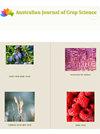Management of fungicides can affect resilience of cultivars to foliar diseases in oats
Q3 Agricultural and Biological Sciences
引用次数: 0
Abstract
The entry and progression of oat foliar diseases affect yield potential, requiring a combination of genetic resistance and management technologies. The objective of the study is implementing a management system to reduce the use of fungicide in oats by the anticipation of the application and a longer interval from the last application to the grain harvest, together with the identification of cultivars that are more resilient to disease. The study was developed in 2018 and 2019, in soil of type Typical Dystroferric Red Latosol and Cfa (humid subtropical) climate, in Augusto Pestana, RS, Brazil. The experimental design was randomized blocks with three replications in a 23 x 5 factorial, for 23 oat cultivars and 5 conditions of fungicide use: control (no application); one application 60 days after emergence (DAE); two applications at 60 and 75 DAE; three applications at 60, 75 and 90 DAE and four applications at 60, 75, 90 and 105 DAE, with measurement of grain productivity. In oat cultivation, the early and sequential application of fungicide at 60, 75 and 90 days after emergence guarantees satisfactory productivity with a long interval from the last application to harvest for greater food security. The cultivars URS Altiva and IPR Artemis show resilience in the presence of foliar diseases in the absence and reduced use of fungicide, facilitating the transition between conventional and agroecological agriculture in oat cultivation施用杀菌剂可影响燕麦品种对叶面病害的抵御能力
燕麦叶面病害的发生和发展影响产量潜力,需要遗传抗性和管理技术的结合。该研究的目的是实施一种管理系统,通过预期施用和延长从最后一次施用到谷物收获的间隔,以及鉴定抗病性更强的品种,减少燕麦中杀菌剂的使用。该研究于2018年和2019年在巴西RS奥古斯托佩斯塔纳的典型负营养红红壤和Cfa(湿润亚热带)气候类型的土壤中进行。试验设计为23 × 5因子随机区组,设3个重复,23个燕麦品种,5个杀菌剂使用条件:对照(不施用);出现后60天(DAE)一次施用;两个应用在60和75 DAE;在60、75和90 DAE处进行3次施用,在60、75、90和105 DAE处进行4次施用,并测量粮食生产力。在燕麦种植中,出苗后60、75和90天的早期和连续施用杀菌剂可以保证令人满意的生产力,从最后一次施用到收获的间隔时间很长,从而提高粮食安全。栽培品种URS Altiva和IPR Artemis在没有使用杀菌剂和减少使用杀菌剂的情况下表现出抗叶面病害的能力,促进了传统农业和农业生态农业在燕麦栽培中的过渡
本文章由计算机程序翻译,如有差异,请以英文原文为准。
求助全文
约1分钟内获得全文
求助全文
来源期刊

Australian Journal of Crop Science
农林科学-农艺学
CiteScore
1.20
自引率
0.00%
发文量
75
审稿时长
3.5 months
期刊介绍:
Information not localized
 求助内容:
求助内容: 应助结果提醒方式:
应助结果提醒方式:


